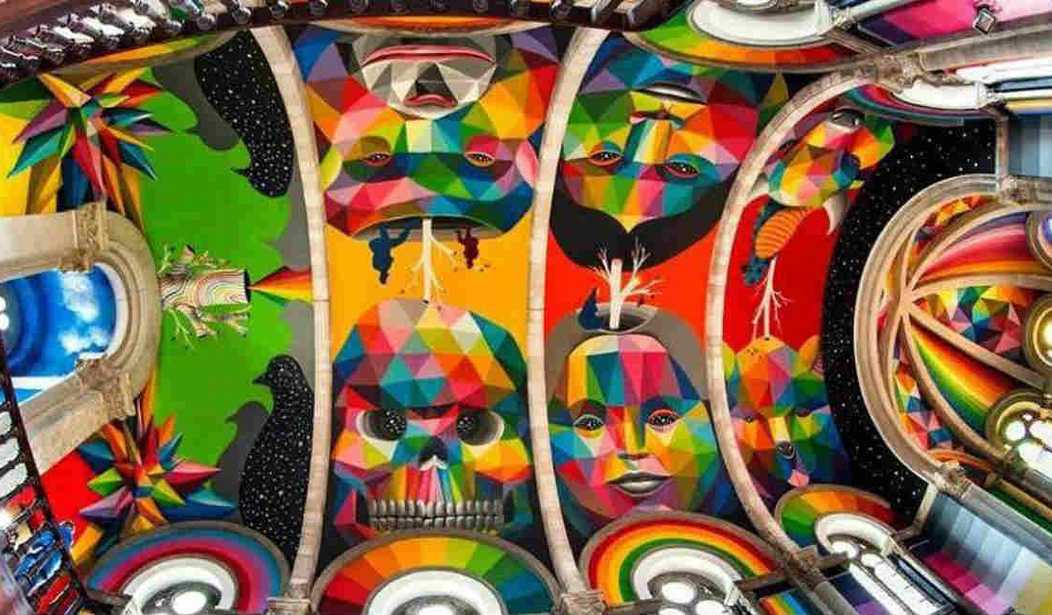Constructed in 1912, the Church of Saint Barbara in the northern Spanish town of Llanera was the house of worship for workers at a local munitions factory. But at the end of the Spanish Civil War, the factory closed, and with it went the church’s congregation.
Abandoned for decades, Saint Barbara was decaying when skateboarding fan Fernandez Rey, enchanted by the lovely architecture and abundance of light, decided to transform the space into an indoor skate park — essential in the region, which gets rain on 200 out of 365 days.
Rey and his pals formed a group called the Church Brigade and set about raising money to build a ramp in the church nave. As more money came in, the notion of an entire skate park evolved.
As word of the project spread, it attracted the attention of Madrid-based artist Okuda San Miguel, who calls it his “personal Sistine Chapel” (pardon the video’s eccentric English captions).
Now covered in rainbow murals that represent San Miguel’s idiosyncratic iconography, walls that once rang with song and prayer now echo with the sounds of shouts, cheers and skate wheels.
Changing demographics and shifting populations over the 2,000 years of Christianity around the world have caused many churches to be built, and many more to be abandoned.
Some of those have continued to crumble and decay, while others have, like Saint Barbara — now La Iglesia Skate — have become civic buildings and private homes.
A 2013 piece at inhabit.com offers a photo essay of six former houses of worship that have found new lives, saying:
Is modern day shoebox housing your idea of a living hell? Or does residing in a converted church come closer to a personal heaven? Here at Inhabitat we’ve covered many amazing examples of renovated churches around the world, from heavenly homes and kindergartens, to even a magnificent 15th century church turned into a library. Adaptive-reuse projects like these are essential to protecting cultural heritage sites and preserving architectural works, but they also do a great deal more by transforming otherwise abandoned spaces into something new everyone can enjoy.
In each case, many of the original features of the churches — Gothic design, stained-glass windows, and soaring vaulted ceilings — have been retained in their new incarnations.
A 2012 photo essay at interiorholic.com looks at 12 churches that have become private homes:
The reuse and repurpose of old buildings can be not only money-saving but also history-preserving. Some of these beautiful churches turned into modern homes were to be demolished. It might not suit everyone’s tastes but coverting churches into houses have become very popular. Old churches have a distinct architecture style that is both grand and appealing.
As recounted in a photo essay at littlethings.com, one British couple decided to blend old and new in its renovation of the St. Nicholas Church, built in the 1790s in the UK region of Northumberland, and deconsecrated in the 1980s. It includes a acre of land, a garden and outbuildings; inside, there are four to five bedrooms, two baths, two reception rooms and an open-plan living area.
After one couple fell in love with the church, they decided to buy it and move in. They restored key elements, like the vaulted ceilings and original stained glass windows, and they invested time and money to maintain the structure while re-adapting the interior to give it a modern home atmosphere.
The exterior remains intact, except for skylights running the length of the roof. Original stained glass windows throughout and repurposed church fixtures abound, and much of the original seating in the church was refinished and placed throughout the home. And unused wood and building materials were fashioned into a dramatic staircase leading from the main living space to an upper-level library.
Of course, one alternative to this is to see that churches aren’t abandoned in the first place. Sometimes, it can’t be helped, but other times it’s a question of awakening people to the historic and architectural gems that may exist in their own neighborhoods.
Beginning in 2010 in Buffalo, New York, the “Mass Mob” movement organizes Catholics in a region to, once a month, choose a forgotten inner-city church and fill its pews with worshipers (and its coffers with a bumper crop of Sunday offerings).
Said organizer Christopher Byrd in a 2010 piece at Breitbart.com:
The Catholic churches we select are heritage churches. They were formed because of the massive immigration to Buffalo from European countries in the late 1800s and early 20th Century. The Polish, Irish, Italian and German populations exploded here. With this explosion, it saw the formation of a lot of Catholic parishes and churches that mirrored the churches of these cultures’ own countries.
It gives members a chance to experience a church and worship in places that are still used as they were 100-150 years ago. It means a lot to help connect people with them. These churches were built by very humble people, faithful people and people with little money. They built these places as a testament to their faith. These churches built by our ancestors were their gift to Buffalo.
Whether they remain churches or not, these buildings represent not only history but the love, care and efforts of thousands of souls over decades or centuries. Preserving them maintains vital links to the past — and keeps their beauty alive in the world.









Join the conversation as a VIP Member